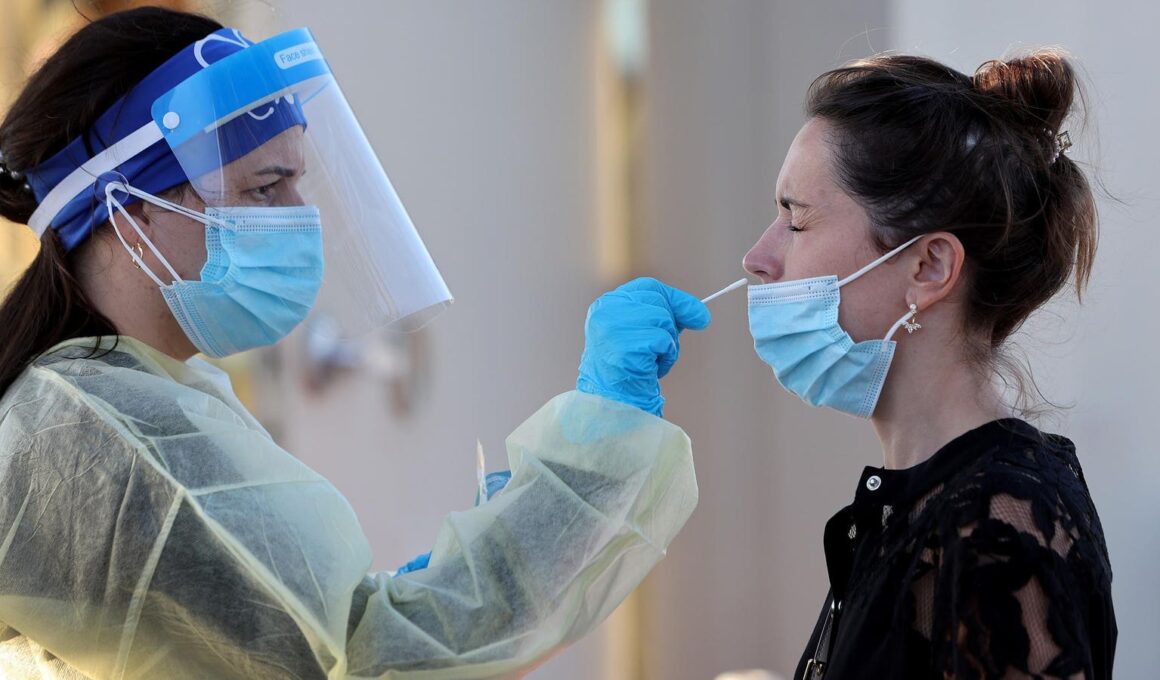Topline
A summer COVID-19 surge has led to a likely rise in infections in half of U.S. states, according to the Centers for Disease Control and Prevention, a spike that comes as drug makers await approval for new vaccines that will target the coronavirus’ latest variant—though hospitalizations remain fairly low.
Jordane Domain gets a COVID-19 test done by a healthcare worker on January 13, 2022 in North Miami, … [+]
Key Facts
COVID-19 infections are growing in 14 states and likely growing in another 11, according to CDC data from Tuesday, the most recent data available, with only five states expected to be currently experiencing a decline in cases (figures are stable or unclear in the other 20 states).
Levels of SARS-COV-2—the virus that causes COVID-19—in wastewater are “very high” in 33 states including Texas, Florida and California, six more than reported the week before, and “high” in another 11, CDC data released Thursday shows—a common early indicator for jumps in coronavirus infections.
Covid cases have surged over the summer for the last several years due to the emergence of more transmissible variants, people gathering indoors to escape the summer heat and jumps in travel, according to Johns Hopkins.
This year’s summer surge could end up being the largest seen in the season since the virus first started circulating in 2020, public health expert Ashish Jha told NBC News, but hospitalization and death rates remain relatively low compared to those of summers past (as of May, hospitals are no longer required to report COVID information to the CDC).
The surge has been partially attributed to three new variants that have evolved enough from their parent virus, JN.1, that immunity from past infections isn’t as effective and as millions of American children head back to school.
Get Forbes Breaking News Text Alerts: We’re launching text message alerts so you’ll always know the biggest stories shaping the day’s headlines. Text “Alerts” to (201) 335-0739 or sign up here: joinsubtext.com/forbes.
Contra
Hospitalization rates remain low. As of the week ending Aug. 10, the latest data available, 3.2 people were being hospitalized due to COVID for every 100,000 people in a given area, higher than the same week in 2023 (when 2 people were hospitalized) but lower than the three seasons before (6.3 people were hospitalized in the same week in 2020, 5.8 in 2021 and 7.7 in 2022). The rate of 3.2 hospitalizations per 100,000 is also much lower than the 2023-2024 season peak of 7.8 hospitalizations per 100,000 people in late December.
Crucial Quote
“Our hospitalization rates are down, so even if we are testing and seeing more [COVID], it seems to be having less of an impact on our susceptible populations,” Michael Phillips, chief hospital epidemiologist for NYU Langone Health in New York City, told NBC.
Where Are Covid Infections Rising?
The CDC says COVID inflections are growing or likely growing in California, Washington, Idaho, Arizona, New Mexico, North Dakota, South Dakota, Minnesota, Illinois, Nebraska, Kansas, Iowa, Arkansas, Mississippi, Kentucky, Tennessee, West Virginia, Virginia, South Carolina, Georgia, Alabama, Vermont, Massachusetts, Pennsylvania and Rhode Island. Cases are likely declining in Alaska, Hawaii, Louisiana, Florida and New York. Other states were either staying stable with their rates of COVID infection or weren’t estimated by the CDC.
What To Watch For
Updated vaccines from Pfizer, Moderna and Novavax to protect against new variants are expected to be approved as soon as next week, according to the Washington Post, and the shots could be available to the public as soon as Labor Day. COVID cases historically spike in the fall and winter months.
Tangent
The first COVID vaccines became available in December of 2020 for adults and booster/variant-specific shots have been made available every year since. This year’s vaccines will focus on the JN.1 variant and the KP.2 strain of the JN line, which was the most dominant variant circulating in the U.S. in May, June and most of July. The CDC recommends everyone over the age of 6 months get an updated COVID vaccine regardless of their previous vaccination status. Moderna and Pfizer’s vaccine will be available for those as young as 6 months old, and Novavax’s shot will be available for those 12 years and older.
Surprising Fact
Drug manufacturers are also working to create a combined vaccine that would inoculate against COVID and influenza at the same time. The combined shot from Moderna had promising clinical trial results, The Washington Post reported, and could be available as soon as next year.
Key Background
COVID-19 first became prevalent in the United States in the spring of 2020 and, by March of 2020, had been declared a nationwide emergency by the Trump administration. More than 1 million cases of COVID had been confirmed worldwide as of April 4 of that year and, by April 5, there had been more than 500,000 confirmed cases in the United States and almost 20,000 confirmed deaths. COVID became the third leading cause of death in the United States in August of 2020 and, by June 20222, more than 84 million COVID cases had been confirmed domestically. Covid deaths in the United States drastically declined in the spring of 2022 and have remained comparably low ever since, reaching a five-year low the week of June 8 this year when 302 people died, according to the CDC.
Further Reading
Mary Roeloffs is a Forbes reporter who covers breaking news with a frequent focus on the entertainment industry, streaming, sports news, publishing, pop culture and climate change. She joined Forbes in 2023 and lives in Dallas. She’s covered Netflix’s hottest documentaries, a surge of assaults reported on social media, the most popular books of the year and how climate change stands to impact the way we eat. Roeloffs was included on Editor & Publisher Magazine’s “ 25 Under 30” list in 2023 and worked covering local news in the greater Boston area from 2017 to 2023. She graduated with a double major in political science and journalism from Northeastern University. Follow Roeloffs for continued coverage of streaming wars, pop culture news and trending topics.
“>









